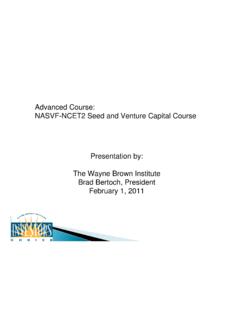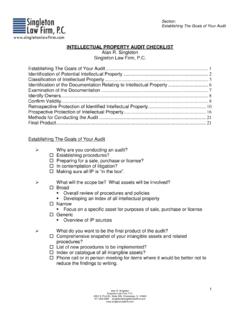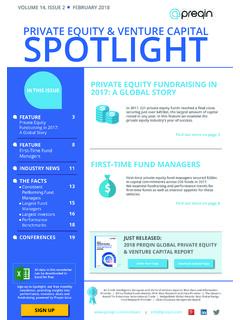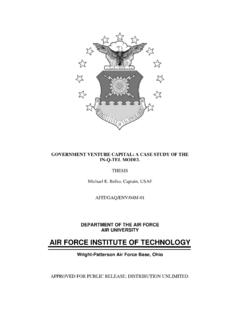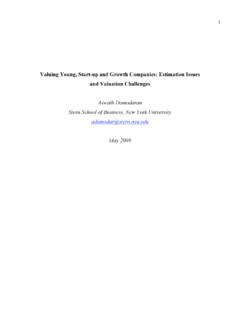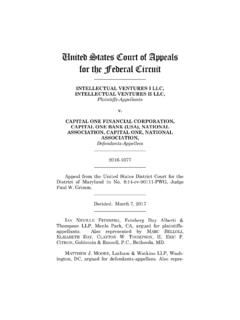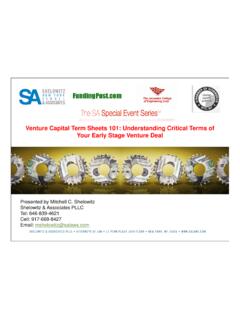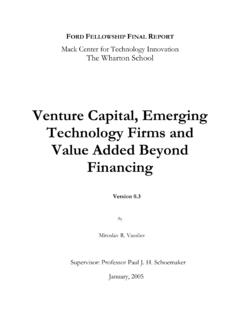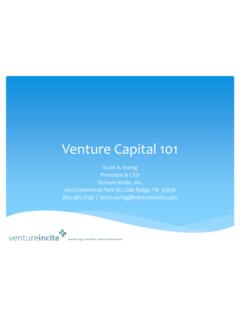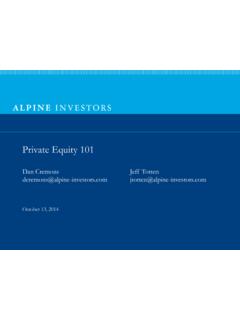Transcription of Seed Funding and Venture Capital Course Certificate Program
1 Seed Funding and Venture Capital Course Certificate Program Greg Horowitt, Managing Director, T2 Venture Capital Kauffman Fellow, Class XV. Overview Introduction to Venture Capital Instruction provided by: Bradley Bertoch, President, Wayne Brown Institute Greg Horowitt, Managing Partner, T2 Venture Capital ; Co-Founder, Global CONNECT, Kauffman Fellow, Class XV. Instruction focus: Introduction of key terms The role Venture Capital plays in the Funding of early stage companies The Venture capitalist as a human capitalist The right Funding for you Preparation and execution Seed Funding and Venture Capital Course Certificate Program Venture 101. Venture 101. Introduction to Private Equity and Venture Capital The Capital Food Chain'. Overview of Venture Capital History Definitions Evolution of the industry Fund stages VCs as individuals Background ( where do these people come from?)
2 Qualities ( are they human?). Style ( are they all so arrogant?). Leadership ( how can I learn from them?). What motivates them? Where do they find their deals? How do they assess an opportunity? Venture 101. The Entrepreneur How do you assess the right type of Capital for your company? Horses for courses How much do you really need? All Venture firms are NOT the same How do you know if it's the right fit? What diligence should you do on the investor / firm? Besides Capital , what else do they bring? The rich or king' dilemma What do YOU want??!!! Why you .and why now? What is your business really worth (valuation)? Having a company having a business What will the VCs expect from you? ( besides your first born child). Communication (how to read the abstract signals some VCs send). How do you get them to notice you? When will they make you rich beyond your wildest dreams?
3 Risk and Rewards The Capital Food Chain Friends,family,fools Inside' money Grants, SBIRs, etc. Not equity Angels Seed Equity VCs Early Mid, Late Strategic Partners Early, Mid, Late Venture Debt Mid, Late Stage Liquidity (M&A, Usually later stage IPO). Internet The Birth of Venture CapitalPersonal Computers Integrated Circuits Venture Microwaves/ Capital Defense Test Innovation Networks Equipment Vacuum Tubes 1910 1920 1930 1940 1950 1960 1970 1980 1990 2000. Steve Blank, Stanford University 2009. The Growth of Venture Capital East Coast Family Offices Whitney, Rockefeller, Bessemer (1946-1969). West Coast IPOs Varian, Hewlett Packard, Ampex (mid to late 50's). SBIC Act of 1958 (SBA). 3:1 government match 700 SBIC funds by 1965. Limited Partnerships External investors as LPs (pension funds, endowments, HNW). The General Partners (GP) manage the money in exchange for: 2% management fee 20% of the carried interest (profits).
4 Capital Gains Reduction ( 78). 28%. ERISA (Employee Retirement Income Security Act ( 79). Pension Funds can invest Venture Capital is Born Draper, Gaither & Anderson ( 58). Rock and Davis ( 61). Sutter Hill ( 64). Patricof & Co. ( 69). Kleiner Perkins ( 72). Sequoia ( 72). Types of Investment Capital Angels Usually a wealthy individual who wants to stay active and involved'. Often has some knowledge or connection to the technology or life sciences world Usually makes smaller investments ($25-50K per investment as part of an angel group, or perhaps more as a single investor). Wants to stay involved and feels their contribution to the start up goes beyond the cash' invested. Institutional VC. Professionally managed (GP). Usually have a theme' or focus (sector, stage, industry, etc). Money raised from pension funds, endowments, high net worth individuals, fund of funds, sovereign wealth funds, etc.)
5 Most often set up as a Limited Partnership 2/20 (management fee + carried interest). Grants Non-dilutive investment Government programs Foundations Types of Investment Capital Strategic Ventures Usually corporate (think Intel, Qualcomm, Novartis, Google). Often a focus on companies that are complimentary and synergistic to their internal efforts Balanced ROI with strategic goals Most often not the lead', and will invest with institutional VCs Private Equity Invest in the tangible assets of a company Buy low, sell high Usually an investment bank that is compensated as a percentage of the deal Usually syndicated Capital Motivated by ROI. Banks Issue debt (loans) secured by assets (receivables, property, equipment, etc.) or other assets (including intellectual property). Entrepreneurs: Go Where the Investors Are Number of Investors Angels Valley of Death VCs $5 million $10 million Investment (one round).
6 New Company Formation Source of Funds <100 IPOs (VC funded). Typical < 500 VC Seed/Start-up Investments Year 40-50,000 Angel Investments 500-700,000 New Companies 0 200,000 400,000 600,000 800,000. Outside Equity Capital for Entrepreneurs <1 in 10 Start-ups obtain angel financing <1 in 1000 Start-ups are VC financed <1 in 10,000 new companies go public <1 in 10 angel deals see VC money Stage ROI 5 year increase Seed 60% 10x+. Start-up 50% 8x Early 40% 5x Mid 30% 4x Later 25% 3x Investment $2 million Exit Year 5th Year Revenues (5th year) $40 million Net Profit (5th year) 10% = $4 million P/E (industry) 12X. Company Value $48 million Required ROI 50% = 8X. Required Capital Growth $16 million % Equity Required at Exit 33%. Pre-money Valuation $4 million * In reality, we would need more than 33%, since dilution will probably occur Venture Mechanics: Valuation Pre-money V: agreed value of company prior to this round's investment (I).
7 Post-money valuation V = V + I. VC equity in company: I/V = I/(V+I), not I/V. Example: $5M invested on $10M pre-money gives VC 1/3 of the shares, not . This should be viewed as a partnership, not an acquisition I and V are items of negotiation Generally company wants large V, VC small V, but there are many subtleties . This round's V will have an impact on future rounds Possible elements of valuation: Multiple of revenue or earnings Projected percentage of market share The Venture Lifecycle Deal Sourcing Deal Structuring Value Creation Preparation for exit Liquidity event Venture Mechanics Deal Sourcing: Where do VCs find deals? Other VCs Service providers (lawyers, accountants, etc). Angel investor groups Individual angels .from a trusted colleague / friend in their network Analysis (research). Scouting universities and other Research Labs Looking at opportunities in a related space to existing portfolio companies Rarely, but on occasion: Funding programs such as SBIR, STTR.
8 Trade Organizations Business Plan Competitions Corporate events Networking events Venture Mechanics Deal development: What do they look for? Great management that is emotionally competent Market opportunity that is trending in the right direction Sustainable competitive advantage Managed and mitigated risk Convinced that people will buy the product and hopefully buy it again and again and . Solid team with high integrity Strong IP position and / or significant trade secret Entrepreneurial passion, relentlessness imagination, flexibility, coachability, and pushing hard at the edges'. VCs want to be assured that they will get their money out before they die Venture Mechanics Deal Evaluation Business Technology Product Model & Market Strategy Intellectual Management Talent Culture Property Policy and Partnering Capital risk and Supply Exit Regulatory Chain What must we confirm?
9 How do we calibrate the opportunity against the market? What don't we know, and what is the risk of not finding out? How do we find this information and what is the cost? Are there any deal killers? You, the Entrepreneur Deal Structuring Alignment of goals and expectations What motivates you, the entrepreneur? Fame? Wealth? Peer positioning? Social good? Do you play nicely with others? What do you want for yourself, and where do you see yourself 5 years from now? How do you assess if you should take outside, dilutive Capital ? How do you do due diligence on a potential investor? Look at their portfolio companies, and identify synergies Talk to their entrepreneurs Ask around. Find out about the individual as well as the firm. What diligence will they do on you? (Answer: Everything). Value Creation What the VC will bring to the table The pre-investment relationship Helping entrepreneurs validate, calibrate, and refine value proposition Assistance in building global advisory boards Introductions to other investors Mentorship and education Helping them understand what's ahead The post-investment relationship Being an effective board member Mentorship, coaching and insights Using networks to accelerate value creation Access to high quality talent Access to domain and market experts Access to customers and partners Access to licensees / licensors Engineering a liquidity event Value Creation What will you bring to the table?
10 Execution and adaptation off business model to market demands and customer needs Being able to attract, motivate, and empower team members Being capable of synthesizing new ideas, and demonstrating relevance Being able to mobilize and allocate resources efficiency and effectively Giving customers what they need, AND what they want Leadership and talent development Staying authentic'. How to use 360 feedback (from customers, team, market trends, valued advisors). The Exit! Exits Preparing for the exit Timing Factors which influence the timing Market conditions Investor desires Entrepreneur desires Capital constraints Offers for mergers or acquisition Availability of necessary future resources Competition Mechanics Communication Execution THANK YOU. Greg Horowitt Managing Director
